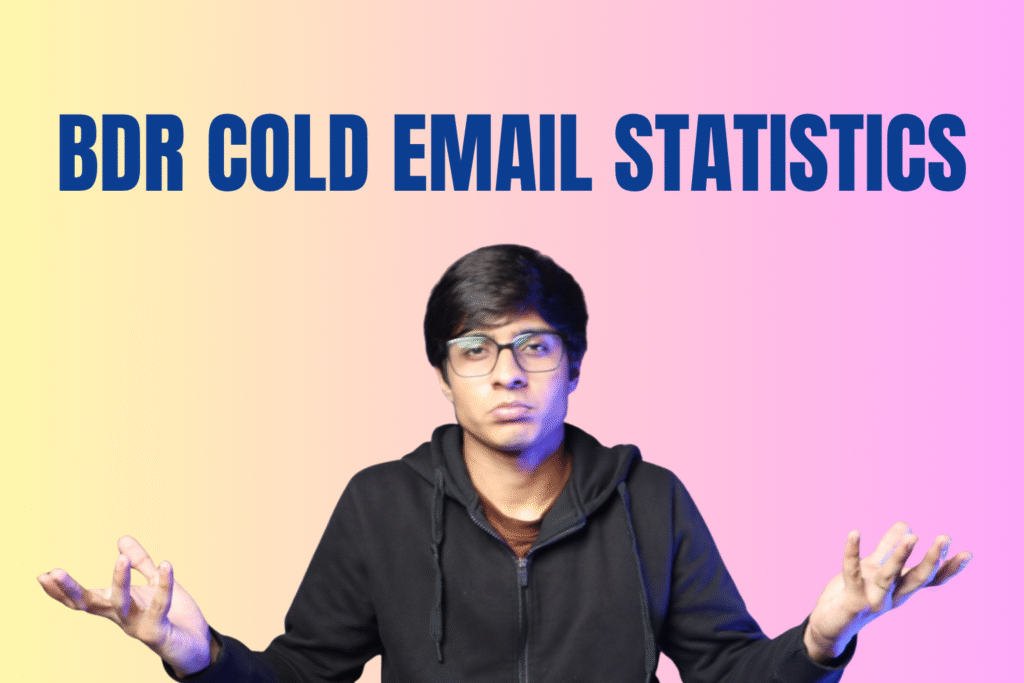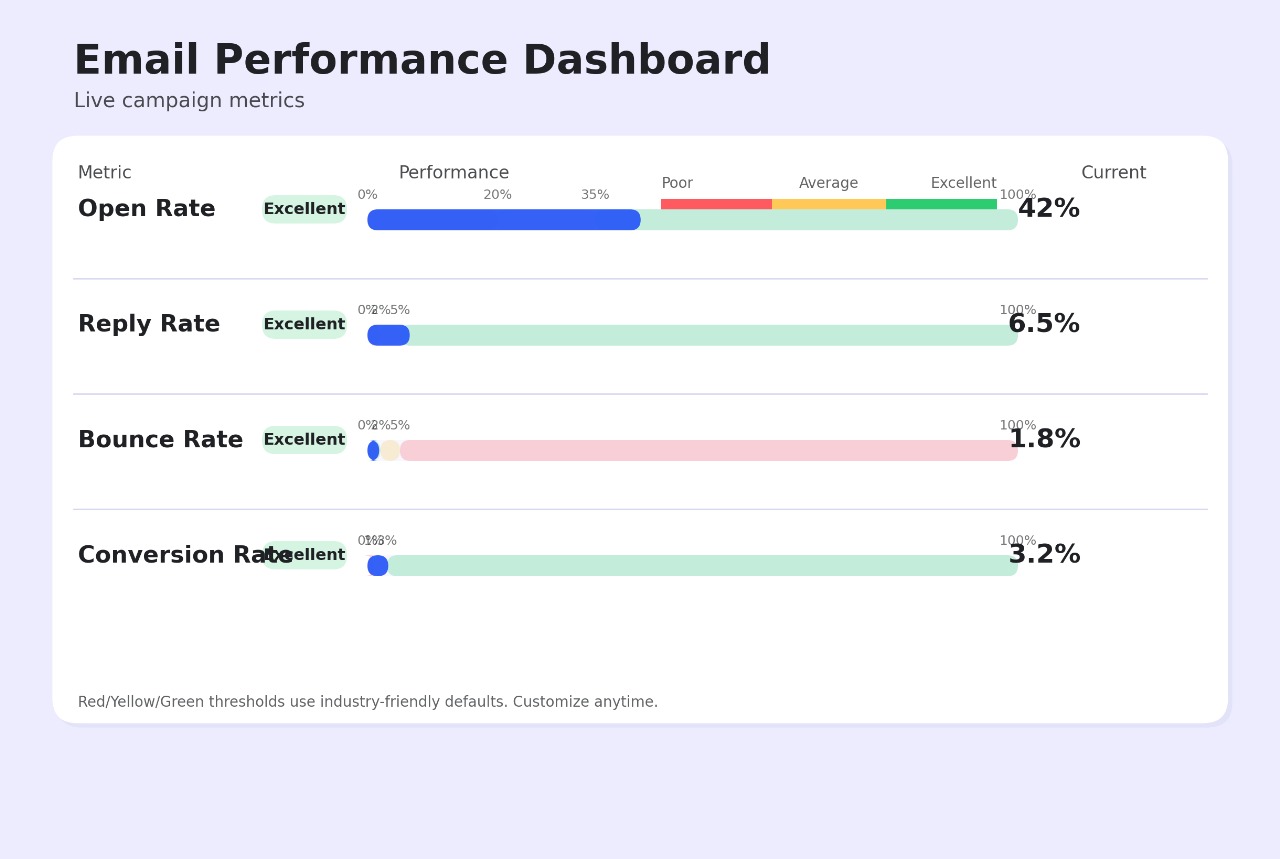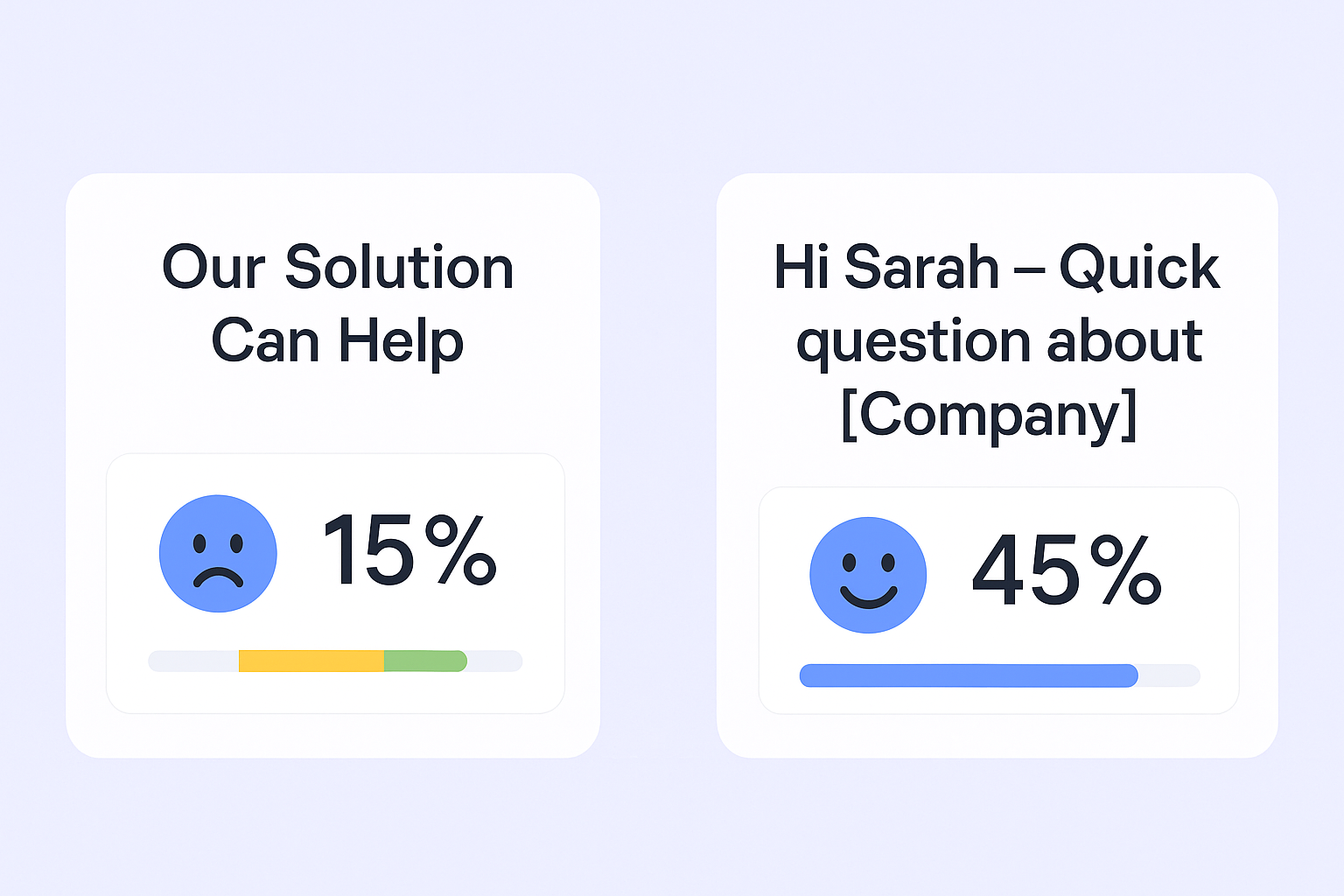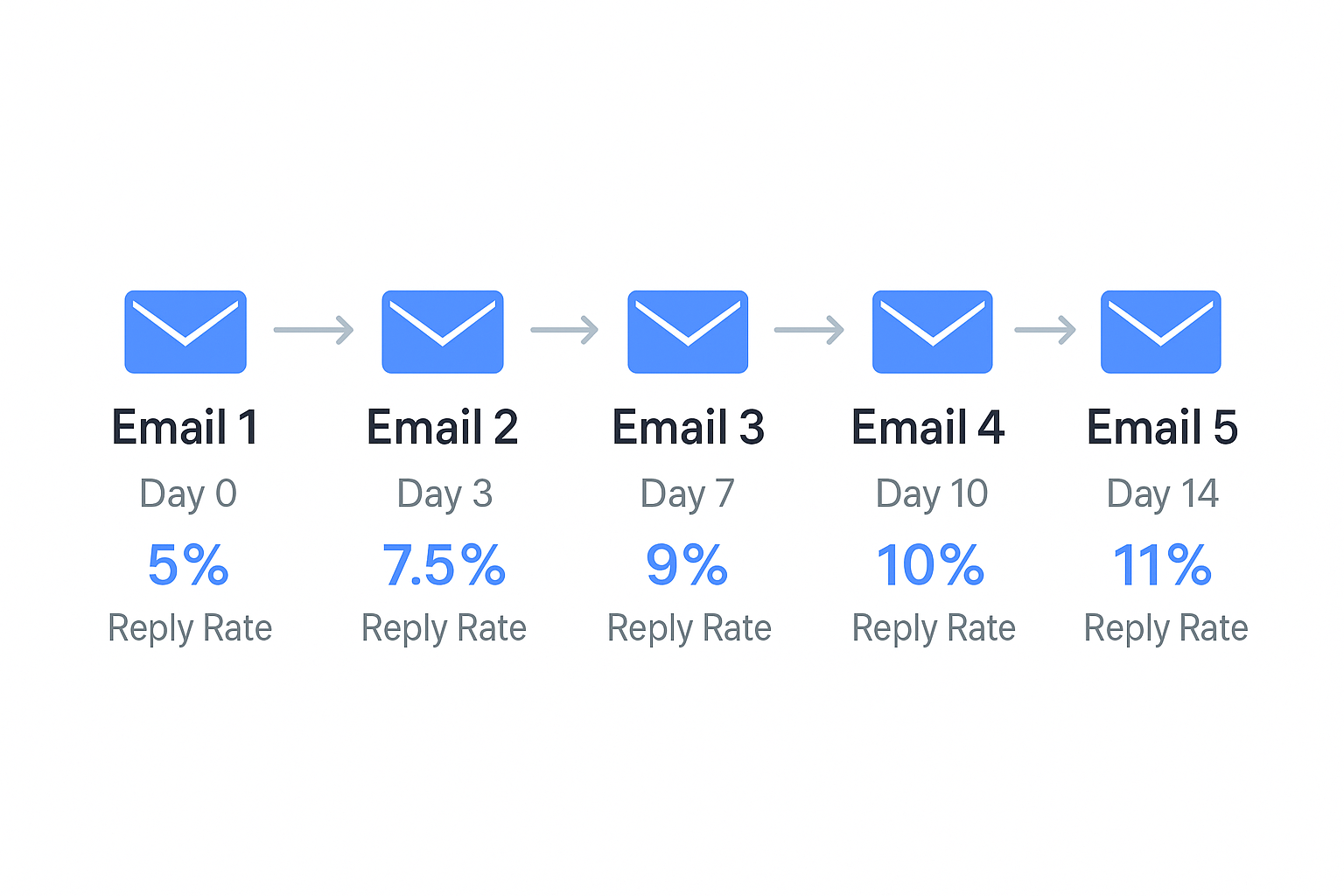- blog
- Statistics
- Cold Email Statistics 2025: 18 Stats That Drive Results

Table of Contents
Cold Email Statistics
- 95% of cold emails fail to get a reply, showing the massive challenge of cold email outreach in 2025
- Over 361.6 billion emails are sent every single day, with spam making up nearly half of all email traffic
- Average person gets over 10 cold emails per week, and 80% of them aren’t even relevant to what they need
- Average cold email reply rate has dropped to 5.1% from around 7% the previous year, showing declining effectiveness
- Top-tier senders using hyper-personalized, targeted outreach are hitting reply rates of 15%, 25%, or even higher
- Average cold email open rate is around 27.7%, but for B2B campaigns a more realistic benchmark is 15-25%
- Average conversion rate for cold email campaigns is a stark 0.2%, requiring approximately 500 cold emails for one qualified opportunity
- Cold email delivers $36-$42 ROI for every $1 spent, making it one of the most profitable channels when executed correctly
- Personalized subject lines boost opens by 26%, and including company name improves open rates by another 22%
- Tuesday is the best day to send cold emails, with open rates up to 16% higher than other days
- Emails between 50-125 words can see 50% higher reply rates than longer messages, proving brevity wins
- Emails containing 6-8 sentences deliver the highest reply rate at 6.9% and strong 42.67% open rate
- Advanced personalization can achieve up to 18% reply rates—more than double the 7-9% rate for generic templates
- Cold emails containing links have 27-35% higher spam rates than those without in initial outreach
- First follow-up alone can increase replies by 49%, yet 48% of sales reps never send a single follow-up message
Look, let’s be honest. Your inbox is a warzone.
You’re sending hundreds of emails every week, crafting what you think is the perfect message, only to be met with… crickets. It’s frustrating. It feels like screaming into a void while everyone else seems to have cracked the code.
If this sounds familiar, you’re not alone. Here’s the reality: 95% of cold emails fail to get a reply. That’s not meant to discourage you—it’s meant to wake you up. The game has completely changed in 2025.
Right now, over 361.6 billion emails are flying around the internet every single day. With spam making up nearly half of all email traffic, providers like Google and Microsoft have built walls around inboxes that would make a castle jealous. The average person gets over 10 cold emails per week, and here’s the kicker: 80% of them aren’t even relevant to what they actually need.
The old “spray and pray” method? Dead. Buried. Gone.
Generic, low-effort cold emails aren’t just ignored anymore—they’re actively hunted down by spam filters, deleted without a second thought, or marked as junk faster than you can say “unsubscribe.”
But here’s the good news: the small group of people who are succeeding aren’t just lucky. They’re strategic. They’re data-driven. They know exactly what works and what doesn’t.
This guide is your new playbook. We’ve pulled together 18 critical cold email statistics for 2025 that show you exactly what’s working right now. By the end, you’ll have a clear, numbers-backed framework to break through the noise, boost your engagement, and build a pipeline that actually converts.
Ready? Let’s dive in.
📊 LinkedIn Outbound Beats Email Stats
No spam filters, no bounce rates, no deliverability nightmares. Just direct access to decision-makers.
18 Useful Cold Email Statistics for 2025
Alright, this is where the rubber meets the road. Each of these statistics is a piece of the puzzle. Understand them, apply them, and watch your results transform.
The Foundation – Benchmarks You Can’t Ignore
Before you hit send on another email, you need to know what “good” actually looks like. These core metrics define success in 2025.
Metric | Poor | Average | Excellent |
Open Rate | Below 15% | 15-25% | 30%+ |
Reply Rate | Below 5% | 5-10% | 15%+ |
Bounce Rate | Above 7% | 3-5% | Below 2% |
Conversion Rate | Below 0.5% | 1-5% | 5%+ |

1. The Overall Reply Rate: Average is 5.1%, but top performers hit 15-20%+
The average cold email reply rate has dropped to 5.1% from around 7% the previous year. This shows just how much harder it’s getting to earn a response. While a typical range sits between 5% and 10%, anything below 5% is considered poor performance.
But here’s what matters: top-tier senders who use hyper-personalized, targeted outreach are hitting reply rates of 15%, 25%, or even higher.
Why this matters: This is your North Star. Forget vanity metrics like opens. A reply is the ultimate sign of engagement—it means your message was compelling enough to warrant a human response. Your goal isn’t to settle for the average; it’s to join the elite by applying what actually works.
💬 Get 40%+ Reply Rates Instead
LinkedIn messages average 40% response rates. Our targeting and campaign design guarantees pipeline growth.
2. The Open Rate Reality: 15-25% is the new “average” in 2025
The average open rate has settled around 27.7%, but for B2B campaigns, a more realistic benchmark is 15-25%. This varies wildly by industry. Saturated spaces like SaaS see averages of 25.71%, while consulting can reach as high as 45.7%.
Why this matters: While reply rate is your goal, a dangerously low open rate (below 15%) is a red flag. It’s your first signal that you have a deliverability problem—your emails are landing in spam. Use this metric as a health check for your campaigns, not as a success metric.
3. The Conversion Rate Truth: Expect 1 qualified opportunity for every 500 emails
The data on conversions is humbling. The average conversion rate for cold email campaigns is a stark 0.2%. This means it takes approximately 500 cold emails to generate one qualified opportunity or closed deal. Even well-executed campaigns often only convert between 1% and 5% of prospects.
Why this matters: This statistic is crucial for managing expectations. Cold outreach is a long game that requires persistence and a multi-touch strategy. Don’t get discouraged by low conversion rates on a single campaign—focus on consistent, high-quality activity over time.
4. The ROI That Justifies It All: Cold email delivers a $36-$42 return for every $1 spent
Despite the tough benchmarks, email marketing remains one of the most profitable channels available. Studies show it delivers a potential return on investment of $36 for every dollar spent.
Why this matters: This is the number you share when anyone questions if the effort is worth it. When executed correctly, a cold email strategy is an incredibly cost-effective engine for generating revenue and building pipeline.
The First Hurdle – Getting Your Email Opened
Your message could be perfect, but it’s worthless if it’s never seen. These stats show you how to master the art of the open.
5. The Power of a Name: Personalized subject lines boost opens by 26%
This is one of the easiest wins in cold emailing. Subject lines personalized with the recipient’s name are 26% more likely to be opened. In fact, the simple subject line “Hi {{first_name}}” achieves a massive 45.36% open rate. Taking it further by including the prospect’s company name can improve open rates by another 22%.
Why this matters: This is the lowest-hanging fruit. Never send an email without personalizing the subject line. It’s the difference between looking like a personal message and screaming “mass marketing blast.”

6. The Best Day to Send: Tuesday and Thursday are your best friends
Timing is everything. Data consistently shows that Tuesday is the best day to send an email, with Thursday being a close second. Open rates on Tuesday can be up to 16% higher than on other days. Mondays get lost in the weekend catch-up flood, while Fridays see drop-offs as people check out early.
Why this matters: Don’t send campaigns whenever you finish writing them. Schedule them strategically for mid-week. This gives your message the best statistical chance of being seen when your prospect is settled into their work routine.
7. The Golden Hours: The 8-10 AM and 4-6 PM windows drive the most engagement
Just as the day matters, so does the time. The highest engagement typically occurs between 8 AM and 11 AM in the recipient’s local time, as people check their inboxes first thing. A second peak happens between 4 PM and 6 PM, when people review emails before logging off. Some studies also show success with very early sends (4 AM to 8 AM) that land at the very top of the inbox.
Why this matters: Always schedule your emails based on the recipient’s time zone. Sending at 9 AM your time might be midnight for your prospect, ensuring it gets buried under dozens of messages by the time they wake up.
The Art of the Reply – Crafting a Message That Connects
Once your email is opened, you have about 10 seconds to make an impact. These statistics reveal the secrets to writing an email that earns a response.
8. The “Less is More” Rule: Emails with 50-125 words can see 50% higher reply rates
Brevity is your best friend. Studies show that emails between 50 and 125 words can achieve reply rates up to 50% higher than longer messages. Emails under 200 words consistently outperform their lengthier counterparts.
Why this matters: Your prospect is busy and scanning, not reading. Get to the point immediately. Every word must earn its place. If you can’t articulate your value proposition quickly and clearly, you’ve already lost their attention.
9. The Sentence Sweet Spot: The 6-8 sentence structure yields a 6.9% reply rate
While word count matters, so does structure. Data shows that emails containing 6 to 8 sentences hit a sweet spot, delivering the highest reply rate at 6.9% and a strong 42.67% open rate. Write more than 13 sentences? Your response rate can plummet to just 3.8%.
Why this matters: This gives you a tangible framework. Aim for a few short, punchy paragraphs. This structure forces clarity and conciseness, which respects the reader’s time and dramatically increases your chances of getting a reply.
10. The Personalization Payoff: Advanced personalization can 2x-3x your response rates
This is the single most powerful lever you can pull. Campaigns that go beyond a simple {{first_name}} merge tag and include advanced personalization see reply rates of up to 18%—more than double the 7-9% rate for generic templates. Despite this, only 5% of people personalize every message they send.
Why this matters: This is how you stand out from the 95% of emails that get ignored. Referencing a recent LinkedIn post, a funding announcement, or a shared connection proves you’ve done your homework. It shows you’re a thoughtful professional, not a spam bot. This is how you earn attention.
For more on personalization tactics, check out our guide on personalized email marketing statistics.
🎯 Personalization Without Email Limits
LinkedIn lets you see profiles, activity, and connections before reaching out. True personalization at scale.
11. The Link Trap: Links can increase spam rates by up to 35% in the first email
It’s tempting to include a link to your calendar or a case study, but resist. Cold emails containing links have 27-35% higher spam rates than those without. In an initial outreach, links are a major red flag for spam filters.
Why this matters: Your only goal in the first email is to start a conversation. Do not include any links—no calendar links, no website links, no PDF links. Once you get a reply, you’ve earned the trust to send a link in your next message.
The Winning Strategy – How You Manage Your Campaign
A great email is only part of the equation. How you structure and manage your outreach campaign is just as critical.
12. The Follow-Up Goldmine: The first follow-up alone can increase replies by 49%
Persistence pays off—literally. Sending just one follow-up email can boost your reply rate by an incredible 49%. Yet, a shocking 48% of sales reps never send a single follow-up message. Sequences with 4-7 emails can triple the reply rate of those with only 1-3 emails, jumping from 9% to 27%.
Why this matters: The majority of your meetings will be booked from follow-up emails. If you’re not sending at least 3-4 follow-ups, you’re leaving massive opportunity on the table. Your prospect is busy—assume your first email was missed, not ignored.

13. The Sequence Limit: Effectiveness drops by ~30% after the third follow-up
While follow-ups are critical, there’s a point of diminishing returns. After the massive lift from the first follow-up, the second adds only another 3%. Effectiveness drops significantly after the third or fourth message, and more importantly, spam complaints begin to rise.
Why this matters: Aim for a sequence of 3 to 5 emails. This strikes the balance between being persistent and being annoying. After that, it’s more effective to move the prospect to a long-term nurture cadence than to continue aggressive follow-ups.
14. The “Small Pond” Advantage: Campaigns with <100 recipients get higher reply rates
Quality trumps quantity every time. Smaller, highly targeted cold email campaigns consistently outperform massive blasts. Sequences sent to 100 recipients or fewer see an average reply rate of 5.5%, while campaigns with over 1,000 recipients drop to just 2.1%.
Why this matters: Instead of building a list of 1,000 prospects and sending one generic message, break it down. Create ten separate lists of 100, grouped by industry, role, or pain point. This allows you to write much more relevant and personalized copy at scale, significantly boosting your reply rate.
15. The Multi-Threading Mandate: Target 1-2 contacts per company initially, then expand
The data reveals a sophisticated strategy. For a single email campaign, targeting just 1-2 contacts per company yields the highest reply rate at 7.8%. Email 10+ people at once? That rate plummets to 3.8%. On the other hand, successful outreach in 2025 involves engaging with an average of 9 individuals per target account over the course of a cadence.
These numbers aren’t contradictory—they describe two different phases. The initial outreach should be a highly targeted sequence to one or two key decision-makers to maximize your chance of getting a reply and establishing a foothold. The “9 contacts” represents the broader, multi-channel effort (including calls and social touches) over a longer cadence—typically around 53 days—to penetrate the entire account.
The Technical Must-Haves – Staying Out of the Spam Folder
You can do everything else right, but if your emails don’t land in the primary inbox, it’s all for nothing. These technical steps are non-negotiable.
16. The Bounce Rate Red Flag: A bounce rate over 7% is damaging your sender reputation
The average bounce rate for B2B cold emails is around 7.5%, but this is dangerous. Anything above 7% is considered bad and will actively harm your sender reputation with email providers. A safe and healthy bounce rate should be in the 3-5% range.
Why this matters: A high bounce rate signals to Google and Microsoft that you’re sending to a low-quality, unverified list. This is the fastest way to get all your future emails sent directly to spam. Using a verified, high-quality data source is absolutely essential.
Want to keep your list clean? Learn more about how to verify email addresses.
17. The Authentication Imperative: SPF, DKIM, and DMARC are your tickets to the inbox
These are technical email authentication records (SPF, DKIM, and DMARC) that prove to inbox providers that you’re a legitimate sender and that your email hasn’t been forged.
Why this matters: Without these records properly set up, you look like a potential spammer or phisher. This is a one-time setup that’s crucial for the long-term health and deliverability of your domain. If you’re not sure if this is done, talk to your sales ops or IT team today.
For more on maintaining healthy deliverability, check out our article on email deliverability statistics.
⚡ Zero Technical Headaches Required
No SPF, DKIM, warm-ups, or bounce rates. We handle complete LinkedIn targeting, campaigns, and scaling.
7-day Free Trial |No Credit Card Needed.
18. The Warm-Up Necessity: 57% of emails land outside the inbox without it
If you take a brand new email account and immediately start sending hundreds of emails a day, you’ll be flagged as a spammer instantly. An email warm-up process prevents this. Studies show that without proper warm-up, 57% of emails land outside the primary inbox.
Why this matters: Warm-up tools automatically and gradually increase your sending volume over a couple of weeks. They send and receive emails from a network of other inboxes, mimicking human behavior and building a positive sender reputation. It’s an essential first step before launching any cold email campaigns.
Got the Data? Now Set Up Your Campaign!
All those numbers can feel overwhelming. Let’s turn them into a simple, actionable checklist you can use to set up your next campaign this afternoon.
Step 1: The Pre-Flight Check (The 15-Minute Fix)
Ask your manager or ops team: “Is our sending domain authenticated with SPF, DKIM, and DMARC?” It’s a simple yes or no question that can make or break your campaigns.
Use a warm-up tool: If you have a new email account, run it through a warm-up service for at least two weeks before launching any outreach.
Verify your list: Before you send, run your prospect list through an email verification tool. Your goal is to get your projected bounce rate under 5%.
Step 2: Build Your “A-List” (Quality Over Quantity)
Keep it small and focused: Create your campaign list with no more than 100 highly relevant prospects to start.
Target with precision: For each company on your list, identify your top 1-2 target personas. Don’t spray and pray across the entire organization.
Step 3: Write Your 3-Part Sequence (The Reply Machine)
Email 1 (The Opener): Keep it under 100 words (and 8 sentences). Personalize the first line and the subject line. Remember: include ZERO links.
Email 2 (The Follow-Up – Day 3): Wait 2-3 days. Don’t just say “bumping this up.” Add a new piece of value—a short insight, a relevant question, or a different angle on their problem.
Email 3 (The Breakup – Day 7): Wait another 3-4 days. Use a polite, low-pressure closing. A simple, “Is this not a priority right now? If so, I’ll stop reaching out,” works wonders.
Step 4: Schedule with Precision (Timing is Everything)
Set your send day: Schedule your entire sequence to start on a Tuesday or Thursday for maximum impact.
Set your send time: Make sure your outreach tool is set to the prospect’s local time zone. Aim for the golden hours: 8-10 AM or 4-6 PM.
Bonus: Use the Right Tools
This is where having the right infrastructure makes all the difference. Salesso provides verified, high-quality email addresses that keep your bounce rates low and your sender reputation healthy. When you’re working with clean data from the start, you’re not just avoiding spam filters—you’re setting yourself up for higher open rates, better reply rates, and more closed deals.
The difference between average results and exceptional results often comes down to starting with verified contacts. That’s exactly what Salesso delivers.
Cold Email Statistics: FAQs
Do open rates even matter anymore with Apple's privacy updates?
How many follow-ups is too many?
Is it better to email a CEO or a manager-level contact?
Should I include a link to my calendar or a case study in the first email?
What's the fastest way to personalize emails without spending hours on research?

LinkedIn Outbound: Better Than Cold Email
Skip spam filters entirely. Reach decision-makers where they’re actively engaged and responsive.
Segmentation That Actually Converts
LinkedIn outbound targets precise demographics with strategic campaign design and scaling methods

